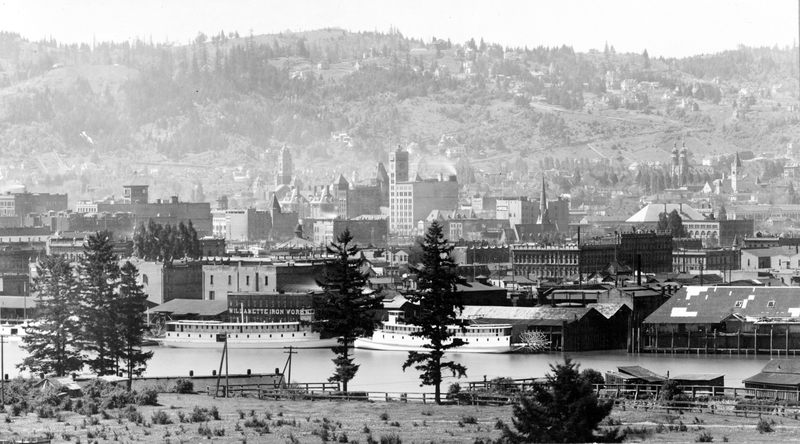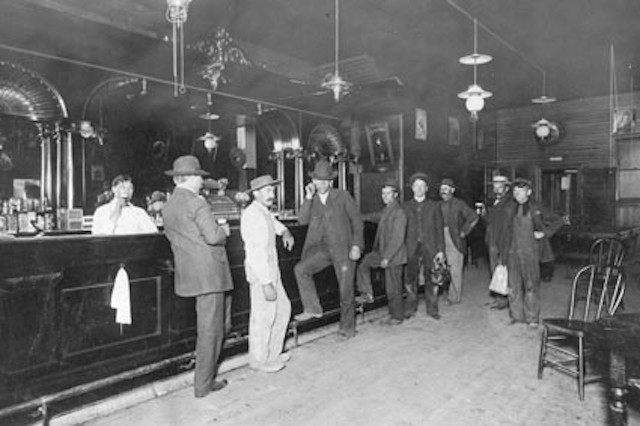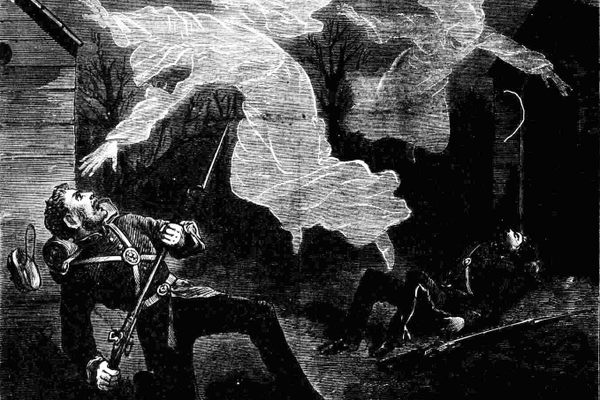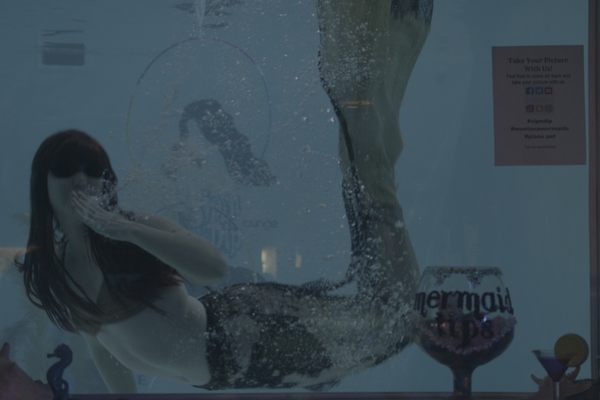All It Takes to Create a Ghost Is a Good Story
A tale of two bars in Portland, Oregon.

When Todd Cobb started writing his book, he believed in ghosts. By the time he finished, he did not.
One day back around 2006, Cobb saw an ad from a regional publisher that wanted to expand its line of books about urban ghosts, from Savannah to New York, to include Portland, Oregon. While he was waiting for a video to render, for his day job as a media producer, he wrote a proposal and the first pages of an introduction, and he got the gig. He imagined himself as a Carl Kolchak–type, a reporter drawn into the world of the supernatural. Kolchak had been the protagonist, played by Darren McGavin, of a couple of 1970s television movies and a short-lived series, The Night Stalker. He wore a perky straw hat with broad ribbon above the brim, as he investigated everything from vampires to murderous androids. So Cobb, then 30-something, with a long face and a furrowed brow, got a hat, put up an ad on Craigslist, and waited for Portland’s ghost stories to start floating in.
If he were to do it again, Cobb says, he would have done it differently. He would vet the people before meeting them, for one thing. “I paid for a lot of coffee without getting much out it,” he says.

A “spiritual cleanser,” for instance, kept him in the coffee shop for almost two hours. He bought her two, maybe even three, fancy coffee drinks, and she told him in great detail about the ghosts that took over her house—how they moved glasses and furniture, smashed things, and worse. After he transcribed the long recording, Cobb went to his neighborhood pub and regaled everyone there with the tales. When he was finished, a woman told him, “That’s the poltergeist.” Yeah, exactly, he explained—“No, no,” she interrupted, “the movie—The Poltergeist.”
Serial disappointments have a way of dulling one’s ambitions. Cobb couldn’t help it if some of the supernatural anecdotes were a bit boring, or if Portland simply didn’t have enough well-documented ghost stories to fill a book. At least one time, he invented a story entirely. It always seemed odd to him to write about “true” ghost stories, but he did get nervous that he was stretching the truth a little too far. But the publisher accepted what he’d written and the book came out in 2007. He became known, at least for awhile, as Portland’s “ghost guy.”
As the ghost guy, he heard more ghost stories, and then a strange thing started happening. He would hear the stories he wrote—parts he knows he made up—repeated back to him, by people he didn’t know and who didn’t realize that they’d read them in a book. He had written in the introduction, “When we move beyond the realm of science, we’re in the realm of faith. We believe because we believe.” But he was surprised that people believed so thoroughly and eagerly in ghosts that he’d just invented.
“The first requirement for there being a ghost in a house is someone believing there’s a ghost in the house,” says Christopher Bader, a professor of sociology at Chapman University in Orange, California, who has spent years studying paranormal beliefs in America. A good story can be enough. So now, two haunted bars featured in Cobb’s book—only one of which had a ghost story prior its publication—are equally haunted.

One of the stories in the book is about a bar called Scooter McQuade’s, though the old brown sign out front only says “Scooter’s.” Its history goes back to the Prohibition era, when it held underground parties—literally, in bootlegger tunnels under the streets. One night, Cobb writes, a gang dressed as police ambushed their drunken rivals, gunning down a whole group of people.
The bar—gloomy, dark, cool, and busy for a weekday afternoon—is just a block past a part of town full of “curated” stores, high-end chains, and white-tiled restaurants. Along one wall, under a red neon sign that says “Knotty Pine,” a couple of guys are hunched over light-up lotto machines.
When I tell the bartender—her name is Veronica—why I’m here, she doesn’t hesitate at all. The bar is definitely haunted, she says. People have strange moments here all the time. Just the other day, the camera in the basement flickered on and off for an hour, with no explanation, and then just started working again. And the ghosts were messing with the toilet seat in the bathroom. Mostly the bartenders notice small things, especially when it’s quiet. Footsteps. A shadow in the corner of the basement storage space. A chair dragging across the floor of the bar when no one’s there.
What makes these little moments seem supernatural? Shadows, stray sounds—those are everywhere. In my office (which, granted, is in a converted old factory building with plenty of quirks), I hear the floor creak, then a couple of pops. Hmm, the leaves of the plant by the window are moving. There are easy explanations—a colleague walking by, an old building’s groans, an air vent. But if I were here alone, at night? Maybe those details wouldn’t seem so harmless.

“When you think about what they’re actually reporting, it’s kind of nothing, right?” says Francis McAndrew, a professor of psychology at Knox College. “It’s only when you’re in a place you believe to be haunted that you find this stuff to be scary.”
McAndrew knows a lot about creepiness. A few years ago he did a study that asked participants to rate how creepy people in a series of photos seemed, and he came to a few conclusions. Men are creepier than women. People think that collecting is a creepy thing to do, especially when it involves insects, dolls, or bones. Clowns are definitely creepy. Too much touching? Creepy. Fascination with death or sex? Also creepy. (Atlas Obscura? Maybe kind of creepy.)
These might not seem like great insights into the human condition, but having data to back them up showed McAndrew what connected them. There’s nothing immediately threatening about insects or dolls or clowns or an extra touch on the shoulder or a cemetery enthusiast. But maybe if you stick around … that could change?
“Creepiness is all about the uncertainty of whether there’s something to be afraid of,” McAndrew says. That ambiguity puts your body on edge and paralyzes your mind as you fight the urge to escape. In a bright sunny room, a floorboard creak can be dismissed as unthreatening. In a dark basement, a place that lends itself to haunting, it’s harder to ignore. An ambiguous sound or a cold draft can send part of the mind to the darkest possible place, even while another part insists that everything’s fine.

Inside Crow Bar an old photo hangs on the wall, of the street it sits on maybe a hundred years before. The building has been around since then, and when the current owners took it over in 2009, they were told it is haunted. The space is long and skinny and, like Scooter McQuade’s, dark in the middle of the day. When I ask the bar staff about ghosts, the reaction is the same as at the other bar—they know there’s a ghost here, because they have had all kinds of spooky experiences. Unexplained sounds. A presence downstairs. Hammering. Shadows in the corner.
“One time I was here and a pint glass flew horizontally off the shelf,” says Anastasia Browning, one of the bartenders. She’d had other creepy moments there, too. “This was the first time I thought, ‘That was not natural.’”
The story about Crow Bar in Cobb’s book described the ghost as a soldier from World War I—so in theory he might be a different kind of specter than the ones at Scooter McQuade’s, who died in the violent gang massacre. The soldier had been sick and wasted away here, and his signature ghost move is supposed to manifest as a wheezing sound or a gust of air. But the experiences that Browning mentioned sounded very similar to the ones from Scooter McQuade’s.

Bader, the sociologist, has been in more haunted houses than he can count, and he says that this is pretty typical. “The things that people get excited about are minor things,” he says. The story that people bring to a place can change what they experience, but it doesn’t change what’s actually happening there. A ghost hunter might go into a haunted house and find herself talking to an old lady, but a demonologist in the same place is going to sense a demon.
One of the main ways our brains process all the stimuli out there in the world is to use what we already know as a framework. When you encounter a new type of tree in the forest, you know it’s a tree, without having to think—it’s tall, it’s got bark, it’s got leaves. Ghost stories work in the same way. When you “know” a place is haunted, your brain immediately identifies creaking board or a flickering light as having a supernatural cause.
Cobb got it right, though, when he wrote that faith is at the core of these stories. “There’s a very powerful desire amongst the general public to believe there’s life after death,” says Bader. “Everything tells us we have this innate desire to believe that it’s not over when we die.” Religion in America is declining, but belief in ghosts is staying stable. If no one wanted to believe in ghosts, Cobb’s stories wouldn’t have any power. But people do want to believe, which makes even newly invented ghosts every bit as real as ghosts that have been around for much longer.
In his book, Cobb wrote about the one time that he did see something he considered inexplicable, in the Commodore Grocery, a small, supposedly haunted, store in a large, old building. Cobb used to go there almost every day to buy cigarettes, and one day, not long after he’d started working on the ghost book, he saw an unnerving woman there—short, “with a dirty white coat and a long, dark ponytail,” who appeared, disappeared, and the next moment appeared again, “blurry, amorphous, and insubstantial one second and solid the next.”
“What I didn’t put in there,” he says, “was that I was so desperately hung over I thought I was going to die. Perhaps I was more sensitive to seeing things from the other world.” When he was collecting ghost stories, he often found that the people who wanted to tell the stories were looking for attention more than anything else. But, though his faith in ghosts was shaken by these encounters, he hasn’t written them off entirely. “When I was young, my grandfather died, and I swear I woke up that night and he was standing in my room to say goodbye,” he says. “I would have sworn that happened, for years. I could have dreamed it. But I was comforted by that experience.”
















Follow us on Twitter to get the latest on the world's hidden wonders.
Like us on Facebook to get the latest on the world's hidden wonders.
Follow us on Twitter Like us on Facebook